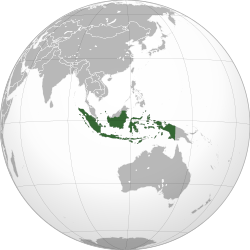Indonésíà
| ||||||||||||||||||||||||||||||||||||||||||||||||||||||||||||||||||||||
Indonésíà (pípè /ˌɪndoʊˈniːziə/ tàbí /ˌɪndəˈniːʒə/), lóníbiṣẹ́ bíi Orílẹ̀-èdè Olómìnira ilẹ̀ Indonésíà (Àdàkọ:Lang-id), jẹ́ orílẹ̀-èdè ní Gúúsùìlàorùn Ásíà àti Oseania. Indonesia ní àwọn erékùṣù 17,508. Pẹ̀lú olùgbé bíi 230 ẹgbẹgbẹ̀rún ènìyàn, òhun ni orílẹ̀-èdè olólùgbéjùlọ kẹrin láyé, ó sì ní olùgbé àwọn Mùsùlùmí tótóbijùlọ láyé. Indonésíà jẹ́ orílẹ̀-èdè olómìnira, pẹ̀lú aṣòfin àti ààrẹ adìbòyàn. Olúìlú rẹ̀ ni Jakarta. Ó ní bodè ilẹ̀ mọ́ Papua New Guinea, East Timor, àti Malaysia. Àwọn orílẹ̀-èdè míràn ìtòsí rẹ̀ náà tún ni Singapore, Philippines, Australia, àti ilẹ̀agbègbè Índíà Andaman and Nicobar Islands. Indonesia jẹ́ ọmọ ẹgbẹ́ olùdásílẹ̀ ASEAN àti ọmọ egbẹ́ Àwọn òkòwò únlá G-20.
Òṣùṣùerékùṣù Indonesia ti jẹ́ agbègbè òwò pàtàkì láti ọ̀rúndún keje, nígbàtí Srivijaya àti Majapahit ṣòwò pẹ̀lú Ṣáínà àti India. Díẹ̀díè àwọn olórí ibẹ̀ gba àpẹrẹ àṣà, ẹ̀sìn àti olóṣèlú láti òkèrè láti ìbẹ̀rẹ̀ àwọn ọ̀rúndún CE, bẹ́ẹ̀sìni àwọn ilẹ̀ọba Hindu àti Buddhisti gbòòrò. Itan Indonesia ti gba ipa latodo awon alagbara okere ti won wa sibe nitori awon ohun alumoni toni. Awon musulumi onisowo mu esin Islam wa sibe, beesini awon alagbara lati Europe ba ara won ja lati se adase owo ni awon Erekusu Spice Maluku lasiko Igba Iwari. Leyin awon orundun meta ati abo iseamusin awon ara Hollandi, Indonesia gba ilominira re leyin Ogun Agbaye 2k. Loni Indonesia je orile-ede olominira aare oniparapo to ni awon igberiko meta le logbon.
Kakiri awon opo erekusu re, Indonesia ni awon eya eniyan, ede ati esin otooto. Awon ara Java ni eya eniyan totobijulo, to si unbori loloselu. Indonesia ti sedagbasoke idamo kanna to ni ede orile-ede, orisi eya-eniyan, iseopo esin larin ogunlogo olugbe musulumi, ati itan iseamuin ati bi won se koju re.Motto orile-ede Indonesia, "Bhinneka Tunggal Ika" ("Okan ninu Opo"), tokasi awon opo orisirisi to da orile-ede yi. Botilejepe o ni olugbe pupo ati awon agbegbe sisupo ololugbe, Indonesia ni awon agbegbe aginju to ni opoelemin giga keji lagbaye. Botilejepe o ni awon ohun alumoni ile pupo aini unba ja gidigidi loni.[5]
Orisun itumo oruko
[àtúnṣe | àtúnṣe àmìọ̀rọ̀]Oruko Indonesia wa lati Latini Indus, ati Giriki nesos, to tumosi "erekusu".[6] Oruko yi lojo lati orundun 18k, ki Indonesia alominra o to je didasile.[7] Ni 1850, George Earl, onimo oro-eyaeniyan omo Geesi, damoran lilo oro Indunesians — ati Malayunesians — fun awon onibugbe "Osusuerekusu India tabi Osusuerekusu Malaya".[8] Ninu iwe yi kanna, akeko Earl, James Richardson Logan, lo Indonesia gege bi oro-oruko kanna fun Osusuerekusu India.[9] Sibesibe awon olukowe ara Hollandi ninuawon iwe lori East Indies won ko lo Indonesia. Dipo, won lo Osusuerekusu Malay (Maleische Archipel); the Netherlands East Indies (Nederlandsch Oost Indië), tabi Indië; Ilaorun (de Oost); ati Insulinde.[10]
lati 1900, Indonesia bere sini wopo bi oruko ninu awon iwe olukowe lodi awon Nedalandi, beesini awon asetorile-ede gba ni lilo gege bi ifihan oselu.[11] Adolf Bastian, lati Yunifasiti ilu Berlin, mugbajumo pelu iwe re Indonesien oder die Inseln des Malayischen Archipels, 1884–1894. Olukowe ara Indonesia to koko lo oruko yi ni Suwardi Suryaningrat (Ki Hajar Dewantara), nigbato da iso akede sile ni Nedalandi pelu oruko Indonesisch Pers-bureau ni 1913.[7]

|
Àyọkà yìí tàbí apá rẹ̀ únfẹ́ àtúnṣe sí. Ẹ le fẹ̀ jù báyìí lọ tàbí kí ẹ ṣàtúnṣe rẹ̀ lọ́nà tí yíò mu kúnrẹ́rẹ́. Ẹ ran Wikipedia lọ́wọ́ láti fẹ̀ẹ́ jù báyìí lọ. |
Itokasi
[àtúnṣe | àtúnṣe àmìọ̀rọ̀]- ↑ US Library of Congress; Vickers (2005), page 117.
- ↑ Department of Economic and Social Affairs Population Division (2009) (PDF). World Population Prospects, Table A.1. 2008 revision. United Nations. http://www.un.org/esa/population/publications/wpp2008/wpp2008_text_tables.pdf. Retrieved 12 March 2009.
- ↑ 3.0 3.1 3.2 3.3 "Indonesia". International Monetary Fund. Retrieved 21 April 2010.
- ↑ "Human Development Report 2009. Human development index trends: Table G" (PDF). The United Nations. Retrieved 5 October 2009.
- ↑ Àṣìṣe ìtọ́kasí: Invalid
<ref>tag; no text was provided for refs namedeconomist1 - ↑ Tomascik, T; Mah, J.A., Nontji, A., Moosa, M.K. (1996). The Ecology of the Indonesian Seas – Part One. Hong Kong: Periplus Editions Ltd.. ISBN 962-593-078-7.
- ↑ 7.0 7.1 Àdàkọ:Id icon Anshory, Irfan (16 August 2004). "Asal Usul Nama Indonesia". Pikiran Rakyat. Archived from the original on 15 December 2006. https://web.archive.org/web/20061215190155/http://www.pikiran-rakyat.com/cetak/0804/16/0802.htm. Retrieved 5 October 2006.
- ↑ Earl, George S. W. (1850). "On The Leading Characteristics of the Papuan, Australian and Malay-Polynesian Nations". Journal of the Indian Archipelago and Eastern Asia (JIAEA): 119.
- ↑ Logan, James Richardson (1850). "The Ethnology of the Indian Archipelago: Embracing Enquiries into the Continental Relations of the Indo-Pacific Islanders". Journal of the Indian Archipelago and Eastern Asia (JIAEA): 4:252–347.; Earl, George S. W. (1850). "On The Leading Characteristics of the Papuan, Australian and Malay-Polynesian Nations". Journal of the Indian Archipelago and Eastern Asia (JIAEA): 254, 277–278.
- ↑ (This term was introduced in 1860 in the influential novel Max Havelaar (1859), written by Multatuli, critical of Dutch colonialism). Justus M. van der Kroef (1951). "The Term Indonesia: Its Origin and Usage". Journal of the American Oriental Society 71 (3): 166–171. doi:10.2307/595186. http://links.jstor.org/sici?sici=0003-0279%28195107%2F09%2971%3A3%3C166%3ATTIIOA%3E2.0.CO%3B2-5.
- ↑ Jusuf M. van der Kroef (1951). "The Term Indonesia: Its Origin and Usage". Journal of the American Oriental Society 71 (3): 166–171. doi:10.2307/595186. http://links.jstor.org/sici?sici=0003-0279%28195107%2F09%2971%3A3%3C166%3ATTIIOA%3E2.0.CO%3B2-5.




